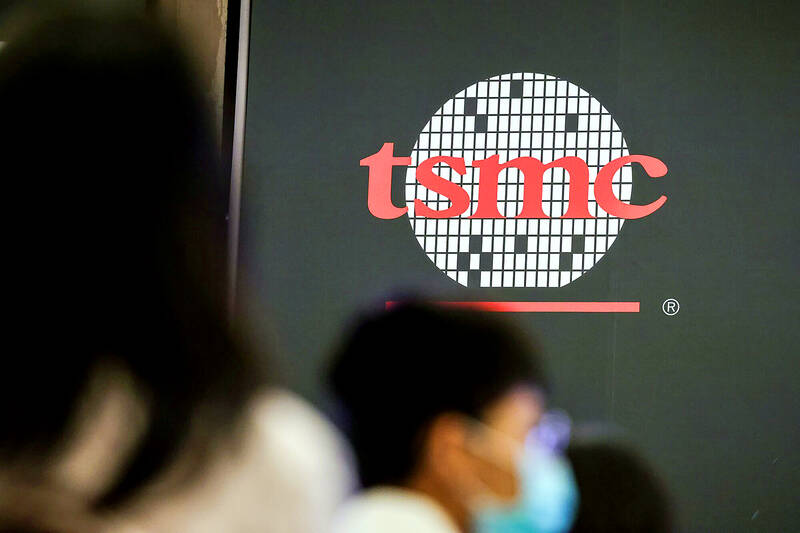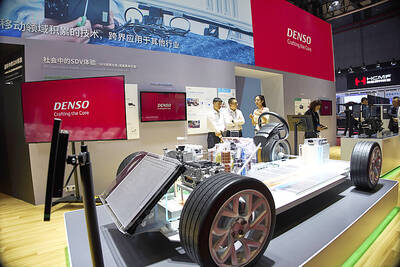Taiwan Semiconductor Manufacturing Co (TSMC, 台積電) last quarter consolidated its leadership position after its share of the global foundry market topped 60 percent, TrendForce Corp (集邦科技) said yesterday.
The contract chipmaker’s market share was 58.5 percent in the final quarter of last year, the Taipei-based researcher said in a report.
TSMC’s revenue fell 16.2 percent sequentially during the January-to-March period to US$16.74 billion, as flagging demand for smartphones and notebook computers reduced utilization of its advanced 7-nanometer, 5-nanometer and 4-nanometer node technologies, TrendForce said.

Photo: Cheng I-Hwa/Bloomberg
TSMC would likely see a slower decline in revenue this quarter, it said.
Samsung Electronics Co, the second-biggest foundry service provider, saw its revenue plummet 36.1 percent quarterly to US$3.45 billion, due to lower utilization of its 8-inch and 12-inch fabs, TrendForce said.
The South Korean company is expected to report the first revenue contribution from its 3-nanometer technology this quarter, the researcher said.
GlobalFoundries Inc ranked third, replacing United Microelectronics Corp (UMC, 聯電), as it benefited from rising orders for chips used in vehicles and industrial devices, as well as the defense sector and government agencies in the US.
GlobalFoundries has said revenue last quarter fell 12.4 percent quarterly to US$1.84 billion.
The company is expected to report a flat second quarter on the back of steady demand for chips used in aerospace, Internet of Things applications and vehicles, TrendForce said.
UMC’s revenue fell 17.6 percent last quarter from the previous quarter, due to weak demand for products made using its 28-nanometer, 22-nanometer and 40-nanometer technologies.
The chipmaker is also expected to see flat revenue this quarter or a slight increase from the previous quarter, TrendForce said.
UMC’s utilization rate of its 8-inch fabs is likely to fall below 60 percent this quarter, as customers scaled back orders for power management chips and microcontrollers, while the utilization rate of its 12-inch fabs could reach 80 percent on the back of rush orders for 28-nanometer chips used in TVs, the report said.
Taiwanese foundries Powerchip Semiconductor Manufacturing Corp (力積電) and Vanguard International Semiconductor Corp (世界先進) fell to eight and ninth place respectively with regards to their global market share, due to sluggish demand for chips used in consumer electronics, TrendForce said.
Overall, the world’s top 10 foundry companies would likely post smaller revenue declines this quarter, as customers have started rebuilding inventory, albeit cautiously, the researcher said.
However, end-market demand remained weak and the companies’ factory utilization would be supported solely by rush orders for Wi-Fi chips and touch-and-display chips, it said.

GROWING OWINGS: While Luxembourg and China swapped the top three spots, the US continued to be the largest exposure for Taiwan for the 41st consecutive quarter The US remained the largest debtor nation to Taiwan’s banking sector for the 41st consecutive quarter at the end of September, after local banks’ exposure to the US market rose more than 2 percent from three months earlier, the central bank said. Exposure to the US increased to US$198.896 billion, up US$4.026 billion, or 2.07 percent, from US$194.87 billion in the previous quarter, data released by the central bank showed on Friday. Of the increase, about US$1.4 billion came from banks’ investments in securitized products and interbank loans in the US, while another US$2.6 billion stemmed from trust assets, including mutual funds,

Micron Memory Taiwan Co (台灣美光), a subsidiary of US memorychip maker Micron Technology Inc, has been granted a NT$4.7 billion (US$149.5 million) subsidy under the Ministry of Economic Affairs A+ Corporate Innovation and R&D Enhancement program, the ministry said yesterday. The US memorychip maker’s program aims to back the development of high-performance and high-bandwidth memory chips with a total budget of NT$11.75 billion, the ministry said. Aside from the government funding, Micron is to inject the remaining investment of NT$7.06 billion as the company applied to participate the government’s Global Innovation Partnership Program to deepen technology cooperation, a ministry official told the

Taiwan Semiconductor Manufacturing Co (TSMC, 台積電), the world’s leading advanced chipmaker, officially began volume production of its 2-nanometer chips in the fourth quarter of this year, according to a recent update on the company’s Web site. The low-key announcement confirms that TSMC, the go-to chipmaker for artificial intelligence (AI) hardware providers Nvidia Corp and iPhone maker Apple Inc, met its original roadmap for the next-generation technology. Production is currently centered at Fab 22 in Kaohsiung, utilizing the company’s first-generation nanosheet transistor technology. The new architecture achieves “full-node strides in performance and power consumption,” TSMC said. The company described the 2nm process as

JOINT EFFORTS: MediaTek would partner with Denso to develop custom chips to support the car-part specialist company’s driver-assist systems in an expanding market MediaTek Inc (聯發科), the world’s largest mobile phone chip designer, yesterday said it is working closely with Japan’s Denso Corp to build a custom automotive system-on-chip (SoC) solution tailored for advanced driver-assistance systems and cockpit systems, adding another customer to its new application-specific IC (ASIC) business. This effort merges Denso’s automotive-grade safety expertise and deep vehicle integration with MediaTek’s technologies cultivated through the development of Media- Tek’s Dimensity AX, leveraging efficient, high-performance SoCs and artificial intelligence (AI) capabilities to offer a scalable, production-ready platform for next-generation driver assistance, the company said in a statement yesterday. “Through this collaboration, we are bringing two